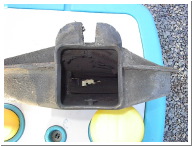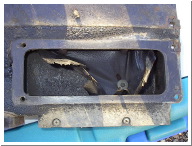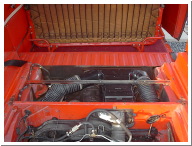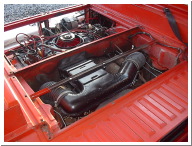
When we got our Greenbrier, it had a heater that more resembled "an asthmatic squirrel wheezing on your foot" than a "blast furnace". At first we thought it was because of the size of the interior, but after reading a number of descriptions on the Corvanatics list of how well other folks' heaters worked, it seemed that it was in need of a little help.
So, I did some research and came up with the following plan, which I posted to VV and the Corvanatics list:
Bob Marlow wrote back the following set of directions:
If you have never done this to an FC heater before, some tips:
Since you specify "clean out heater box" it seems likely that you are familiar with the foam "insulation" that GM put in the rearmost duct originally. It is now all dried-out and disintegrating, and you've probably seem bits of it blowing out of the defroster ducts. It's gotta go. As does all of its remnants inside the ductwork.
To do this properly, the heater box has to be removed from the van. To do THIS properly, you need to be very careful. It is hung from the bottom of the floor panel above the transaxle, AND it is bolted to a very breakable fiberglass duct located under the "step" in the rear floor. It is in this duct that all the foam blockage originates. And it is connected to the rubber duct that leads to the engine compartment upper air hose.
Jack up the van's RH side onto stout jackstands. Removed the RR wheel. This will give you adequate access. Not easy access, adequate. Remove all the screws holding the upper air hose inlet and rubber connector on the engine compartment firewall. Remove the heater hoses. Remove the control cable ends from the heater box. Remove the screw that fastens the heater box to that fiberglass duct. Loosen -- don't fully remove -- the nuts that secure the heater box to the underside of the cargo floor. Carefully slide the heater box rearward, away from the fiberglass duct, and remove.
You can now service the heater box, out of the car. But you've got to get into that fiberglass duct. You can get into it from two places, the inlet port that you just revealed by removing the heater box, and the heat vent in the interior under the rear seat. Vacuum all the crap out of it. If you're ambitious, and you should be if you really want heat, you should remove that duct and really clean and service it. It consists of two halve, riveted together, so it can be opened and then reassembled by the true diehard. Like me. The duct is fastened to the duct that runs forward, and it is fastened to the car itself by four hard-to-see-and-reach bolts. You DO have an assembly manual, right?
Figure on cleaning out all the ductwork that runs forward, too, and cleaning and lubricating the defroster diverter, located under the front seat riser. Removing the RF wheel is the easiest way to get at all this.
The whole job is a huge pain and big time-eater to do right, but the results are spectacular! One winter day, with my Greenbrier heater running, a friend walked up to the car and stuck his head in the window to ask a question. He stopped, mid-sentence, because of the hot air blasting his face, and said "whaddarya doing in here, growing pansies?" On another occasion, with six or so club members sitting in the car at a November autocross, I hit the defroster because we had fogged the windows. The windshield cleared so quickly that it elicted "wows" from my audience.
--Bob
So, here's the duct:



Yes, you're supposed to be able to see through it.
One mod a previous owner of our van did was add a support bar for the heater blower housing so it's not hanging from the transmission cover. This made it a lot easier to work on the system since I could do things from the top, like attaching the heater hoses and adjust the cables. Hank Kaczmarek sold me a refurbished heater box (and donated the money to the CORSA server!) so we had a nice heater box to start with. A couple things I did of note are using the Corvair Underground all plastic and rubber "super" hose and I tie wrapped the pass side hose to the diff dipstick to keep it from possibly sagging onto the exhaust or axle. The previous hose on that side had a hole in it from rubbing on the axle.


Dimensions of the bar are 37 1/2" overall, holes from the left at 5/8", 19 1/4" 28 3/8", and 37". It's mounted offset to the right by 3/4", from the firewall 8 3/4" back on the left and 9 1/4" on the right.
We haven't tried this out in really cold weather, but on a 40 degree night it actually got hot inside the van with the fan on the medium setting after just a few minutes. Success!